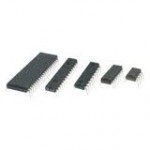Tag: 20X2
Robotics – The PICAXE X2 Series
by Sam on Aug.19, 2011, under Electronics, Microcontrollers, Picaxe
The PICAXE ‘X2’ series of microcontrollers, by Revolution Education Ltd., are Rev.Ed.’s advanced series of microcontrollers. The ‘X2’ series of microcontrollers are feature rich, and much much more powerful than Revolution Education Ltd.‘s previous microcontrollers. The ‘X2’ series consists of the 20X2, 28X2, 28X2 lv*, 40X2, and the 40X2 lv*.
The PICAXE ‘X2’ series of microcontrollers have many great new features. Features like almost every pin being configurable as an input or an output. Also the new PICAXE ‘X2’ series of microcontrollers have up to 3 pins that can be individually configured as hardware interrupt pins. The PICAXE ‘X2’ series of microprocessors have many more ADC channels available, support for touch sensing, and they also have an addition of two internal comparators that constantly compare two analogue values.
The PICAXE ‘X2’ series have much higher clock rates than before. Their default frequency is now 8 MHz as opposed to 4 MHz previously. This increase in frequency has greatly improving the processing speed of the PICAXE chips. The frequency also can be as high as 64 MHz!! The PICAXE ‘X2”s also have a much larger RAM, and up to 4 programming slots available on chip. In addition to the four internal programming slots, up to 4 other slots can be used by connecting an external i2c EEPROM chip – per i2c EEPROM connected! Since up to 8 different I2C chips could be used on the same I2C bus, we have a ‘theoretical’ 32 additional program slots available!
The new PICAXE ‘X2’ microcontrollers also have many more great features such as the ability to communicate with Microchip UNI/O EEPROM memory chips, the servo command now operates at 8 or 32 MHz, there is a new new doze low-power command, internal pull-ups, and many more great features. You can download the PICAXE ‘X2’ product briefing as a PDF from the link below.
(*lv = Low Voltage, 1.8v-3v Version)
| Feature | PICAXE Command | 20X2 | 28X2 | 28X2 5v | 28X2 3v | 40X2 | 40X2 5v | 40X2 3v |
| PIC18F series | 14k22 | 25k22 | 2520 | 25k20 | 45k22 | 4520 | 45k20 | |
| (V) Range | 1.8-5.5 | 2.1-5.5 | 4.5-5.5 | 1.8-3.6 | 2.1-5.5 | 4.5-5.5 | 1.8-3.6 | |
| Firmware Version | C.0+ | B.3+ | B.0-B.2 | B.A-B.C | B.3+ | B.0-B.2 | B.A-B.C | |
| Max In/Ex Freq(MHz) | setfreq | 64/na | 16/64 | 8/40* | 16/64 | 16/64 | 8/40* | 16/64 |
| Variables RAM | peek, poke @bptr | 128 | 256 | 256 | 256 | 256 | 256 | 256 |
| Scratchpad RAM | put, get @ptr | 128 | 1024 | 1024 | 1024 | 1024 | 1024 | 1024 |
(* 32MHz [8MHz resonator with x4 PLL] is recommended for programs using serial commands as 40MHz is not an even multiple of 8 and so does not produce valid serial baud rates.)
See these other articles in the ‘Robotics:’ series…
- Robotics – Intro To Microcontrollers
- Robotics – Intro To PICAXE
- Robotics – Microcontroller ? Microprocessor ? or Microchip?
- Robotics – PICAXE M2/X1 Parts
Please leave your comments and sugestions for future articles in the series below. Thank you. 
Robotics – Intro To PICAXE
by Sam on Jul.06, 2011, under Electronics, Microcontrollers, Picaxe
In my previous post I discussed what a microcontroller is, what a microcontroller consists of, and also a few common types of microcontrollers. In this post I would like to explore the PICAXE microcontroller from Revolution Education Ltd. A PICAXE microcontroller is a standard Microchip PICmicro microcontroller that has been pre-programmed with the PICAXE bootstrap code. The bootstrap code enables the PICAXE microcontroller to be re-programmed directly via a simple serial connection – eliminating the need for an expensive conventional programmer. This makes the whole download system into a very low-cost and simple serial download cable.
Why the PICAXE microcontroller from from Re-Ed.? Well, the PICAXE is a cheap, easy, and a surprisingly capable microcontroller. For just a few dollars, a simple download cable and free programming software available from Re-Ed. you can be up and running with the PICAXE microcontroller. You also get many advanced features with the PICAXE microcontroller such as; parallel multi-tasking, servo support, I2C interfacing, musical ring-tone tune support, ADC inputs, touch sensor inputs, and also standard, infra-red, and serial input/output pins to mention just a few.
The PICAXE microcontroller comes in several different sizes and variants. You can choose between 8, 14, 18, 20, 28, and 40 pin sizes and either standard DIP or SMT packages. There is also a special 28 pin DIP ‘module’ that contains a PICAXE-28X2 (PIC18F25K22) chip, voltage regulator, download socket, and reset switch all in one convenient package Ideal for breadboarding. The variants available are ‘M2’, ‘X1’, and ‘X2′. The older 08, 14, 18 and 20 pin ‘A’, ‘M’ and ‘X’ parts are no longer manufactured as
they have now been superseded by the M2 parts and the older 28 and 40 pin ‘A’ and ‘X’ parts are no longer manufactured and they have now been superseded by the X1 and X2 parts. There is still an 08’M’ module available but I suspect this will be discontinued soon and replaced with an 08M2 module. You can also get an 18’X’ but this has been replaced by the 18M2 and most likely will be phased out unavailable soon. For more detailed information and to checkout the different project boards available see the Revolution Education Ltd. website.
– [The following table shows the primary functional differences between the available PICAXE microcontrollers:]
____________________________________________________________
(For general ‘hobbyist’ the M2 and X2 series are recommended.)
Standard:(800 – 1800 line memory)
| PICAXE uPU : – | Total I/O Pins : – | Max ADC Pins : – | Max Speed : |
|---|---|---|---|
| 08M2 | 5 configurable | 0-3 | 32MHz |
| 14M2 | 11 configurable | 0-7 | 32MHz |
| 18M2 | 16 configurable | 0-10 | 32MHz |
| 20M2 | 16 configurable | 0-11 | 32MHz |
| 28X1 | 0-12in,9-17out | 0-4 | 20MHz |
| 40X1 | 8-20in,9-17out | 3-7 | 20MHz |
Advanced:(2000-3200 line memory, per ea. of (up to) 4 separate slots)
| PICAXE uPU : – | Total I/O Pins : – | Max ADC Pins : – | Max Speed : |
|---|---|---|---|
| 20X2 | 18 configurable | 0-8 | 64MHz |
| 28X2 | 22 configurable | 0-16 | 64MHz |
| 40X2 | 33 configurable | 0-27 | 64MHz |
____________________________________________________________
We will examine the different individual PICAXE microcontroller chips and their individual capabilities in more detail in my next post…




